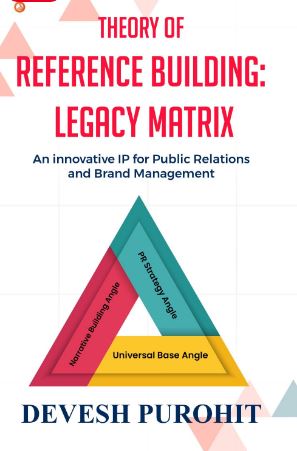In the groundbreaking work, “Theory of Reference Building: Legacy Matrix,” Devesh Purohit unfolds a revolutionary perspective on the global evolution of Public Relations. Grounded in 12 years of scrupulous research and insightful observations, Purohit introduces an all-encompassing framework for legacy building, pushing beyond conventional brand development to craft enduring legacies.

At the core of Purohit’s thesis is the compelling idea that “Legacy is built in the culture.” He meticulously explores this concept, providing readers with insights and elements to navigate diverse cultures and carve out lasting legacies. Delving into historical contexts, Purohit sheds light on pivotal figures who adeptly utilized PR to shape the course of the world.
“Theory of Reference Building: Legacy Matrix” captivates readers with impactful narratives, citing examples from various brands, cultures, and personalities. Case studies, including Mahatma Gandhi and Ferrari, enrich his framework, illustrating its applicability to both human and organizational brands on a global scale.
The book’s writing style is accessible and clear, making the intricate ideas presented within it accessible to a broad audience. Purohit’s seamless integration of diverse examples and concepts into a cohesive narrative enhances the overall readability.
A notable aspect of the book is Purohit’s transparency about his own journey. Inspired by the iconic Shah Rukh Khan, the author openly acknowledges failures in his 2023 pitching endeavors, underscoring the sincerity and authenticity of his commitment to the subject matter.
Devesh Purohit, a seasoned PR Consultant with a decade of experience and a Gold-Medalist in MAPR from Hinduja College, Mumbai, has meticulously crafted “Theory of Reference Building: Legacy Matrix” as a groundbreaking project. His intellectual property, Legacy Matrix, bridges the gap in strategic direction and tactical planning for those aiming to craft a brand legacy.
The book holds particular relevance for thought leaders, founders, CEOs, and artists aspiring to leave an indelible mark. Purohit’s Legacy Matrix stands as an invaluable resource for PR professionals, offering insights into PR strategy, brand building, and advocacy, transforming the role from mere presence building to influential power building.
In conclusion, “Pioneering Legacy Construction: Unveiling ‘Theory of Reference Building: Legacy Matrix'” is a sincere and earnest effort that beckons readers on a transformative journey, presenting a customizable blueprint for legacy building. Devesh Purohit’s contribution to the field of Public Relations is commendable, marking a paradigm shift that will undoubtedly redefine how we perceive and approach brand legacy.

